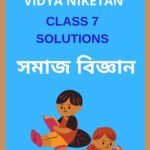SEBA Class 7 Social Science MCQ Chapter 5 Resources Solutions in English Medium, Class 7 Social Science Multiple Choice Question Answer in English to each chapter is provided in the list so that you can easily browse throughout different chapters SEBA Class 7 Social Science MCQ Chapter 5 Resources Notes and select need one.
SEBA Class 7 Social Science MCQ Chapter 5 Resources
Also, you can read the SCERT book online in these sections Class 7 Social Science Objective Type Solutions by Expert Teachers as per SCERT (CBSE) Book guidelines. These solutions are part of SCERT All Subject Solutions. Here we have given Assam SEBA Class 7 Social Science Multiple Choice Notes for All Subject, You can practice these here.
Resources
Chapter – 5
GEOGRAPHY
| MCQ |
1. Which of the following is considered a renewable resource?
(a) Coal.
(b) Natural Gas.
(c) Solar Energy.
(d) Iron Ore.
Answer: (c) Solar Energy.
2. What is the primary characteristic of non-renewable resources?
(a) They can be replenished naturally over time.
(b) They are available in unlimited quantities.
(c) They are finite and cannot be easily replaced once used.
(d) They include resources like water and wind.
Answer: (c) They are finite and cannot be easily replaced once used.
3. Which of the following is an example of a capital resource?
(a) Forests.
(b) Machinery.
(c) Human Labor.
(d) Mineral Deposits.
Answer: (b) Machinery.
4. What type of resource is known for being both scarce and valuable due to its limited availability?
(a) Renewable Resource.
(b) Recyclable Resource.
(c) Non-renewable Resource.
(d) Inexhaustible Resource.
Answer: (c) Non-renewable Resource.
5. Which of the following resources is categorized as a biotic resource?
(a) Water.
(b) Minerals.
(c) Trees.
(d) Sunlight.
Answer: (c) Trees.
6. Which of the following is considered a primary resource?
(a) Processed Food.
(b) Steel.
(c) Crude Oil.
(d) Electricity.
Answer: (c) Crude Oil.
7. What type of resource is a forest considered to be?
(a) Renewable.
(b) Non-Renewable.
(c) Exhaustible.
(d) Artificial.
Answer: (a) Renewable.
8. Which resource is crucial for the production of electronics and batteries?
(a) Gold.
(b) Copper.
(c) Iron.
(d) Coal.
Answer: (b) Copper.
9. What is the main challenge associated with the use of fossil fuels?
(a) They are too abundant.
(b) They are expensive.
(c) They contribute to environmental pollution.
(d) They are easy to recycle.
Answer: (c) They contribute to environmental pollution.
10. Which resource is essential for generating hydroelectric power?
(a) Wind.
(b) Sunlight.
(c) Water.
(d) Biomass.
Answer: (c) Water.
11. Which of the following is a major mineral resource found in Assam?
(a) Iron Ore.
(b) Coal.
(c) Bauxite.
(d) Gold.
Answer: (b) Coal.
12. Assam is well-known for the production of which of the following cash crops?
(a) Cotton.
(b) Tea.
(c) Sugarcane.
(d) Coffee.
Answer: (b) Tea.
13. Which river is crucial for the irrigation and agricultural activities in Assam?
(a) Brahmaputra.
(b) Ganges.
(c) Yamuna.
(d) Godavari.
Answer: (a) Brahmaputra.
14. Which forest resource is a significant part of Assam’s economy and ecology?
(a) Bamboo.
(b) Pine.
(c) Redwood.
(d) Eucalyptus.
Answer: (a) Bamboo.
15. What type of soil is predominantly found in Assam, making it suitable for tea cultivation?
(a) Sandy Soil.
(b) Loamy Soil.
(c) Alluvial Soil.
(d) Red Soil.
Answer: (c) Alluvial Soil.

Hi! my Name is Parimal Roy. I have completed my Bachelor’s degree in Philosophy (B.A.) from Silapathar General College. Currently, I am working as an HR Manager at Dev Library. It is a website that provides study materials for students from Class 3 to 12, including SCERT and NCERT notes. It also offers resources for BA, B.Com, B.Sc, and Computer Science, along with postgraduate notes. Besides study materials, the website has novels, eBooks, health and finance articles, biographies, quotes, and more.




